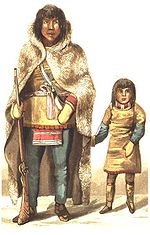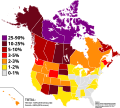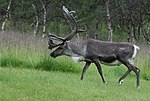Wekweeti Whatì The Tłı̨chǫ (Athapascan pronunciation: [tɬʰĩtʃʰõ], English: /təˈlɪtʃoʊ/ tə-LIH-choh) people, sometimes spelled Tlicho and also known as...
18 KB (1,976 words) - 21:35, 31 August 2024
Dogrib language (redirect from Tłįchǫ Yatiì)
Tlicho language, also known as Tłı̨chǫ Yatıì (IPA: [tɬʰĩtʃʰõ jatʰîː]) or the Dogrib language, is a Northern Athabaskan language spoken by the Tłı̨chǫ...
20 KB (1,535 words) - 17:52, 1 June 2024
The Tłı̨chǫ Government, or Tłı̨chǫ Ndekʼàowo (also rendered Tlicho Government and Tlicho Ndekʼaowo), is a First Nations organization representing the Tłı̨chǫ...
7 KB (483 words) - 17:50, 8 August 2024
List of municipalities in the Northwest Territories (redirect from Tlicho community governments in the Northwest Territories)
community that was established or continued by a legislative order. The Tlicho Community Government Act (TCGA), enacted in 2004, also considers community...
21 KB (1,297 words) - 19:18, 1 September 2024
The Tłı̨chǫ Highway, also known as the Tłı̨chǫ All-Season Road and officially Northwest Territories Highway 9, is a 97-kilometre (60 mi) gravel road in...
3 KB (214 words) - 17:36, 8 August 2024
agreement with the Tłı̨chǫ people created a region within the NWT called Tli Cho, between Great Bear and Great Slave Lakes, which gives the Tłı̨chǫ their own legislative...
79 KB (6,164 words) - 15:13, 18 September 2024
Nunavut in Canada who form the Dene Nation: the Chipewyan (Denesuline), Tłı̨chǫ (Dogrib), Yellowknives (T'atsaot'ine), Slavey (Deh Gah Got'ine or Deh Cho)...
13 KB (1,342 words) - 20:27, 27 August 2024
The Tłı̨chǫ Community Services Agency is the public school board, as well as overseeing health and social services for the North Slave Region communities...
5 KB (212 words) - 07:55, 8 September 2024
"Harvesting means gathering, hunting, trapping or fishing ...". Similarly, in the Tlicho Land Claim and Self Government Agreement, "'Harvesting' means, in relation...
9 KB (994 words) - 02:12, 10 August 2024
Gwichʼin, Inuinnaqtun, Inuktitut, Inuvialuktun, North Slavey, South Slavey, Tłįchǫ 41,070 44,920 1,183,085 163,021 1,346,106 1 1 Yukon YT Whitehorse June 13...
70 KB (4,918 words) - 01:30, 17 September 2024
to the community of Dettah. The now-closed Tuktoyaktuk Winter Road and Tłı̨chǫ winter road systems were replaced by the Inuvik–Tuktoyaktuk Highway (which...
12 KB (362 words) - 04:51, 30 July 2024
Behchokǫ̀ (category Tłı̨chǫ community governments in the Northwest Territories)
[bɛ́ht͡sʰókʰõ̀]; English: /ˌbɛtʃoʊˈkoʊ/) (from the Tłı̨chǫ meaning "Behcho's place"), officially the Tłı̨chǫ Community Government of Behchokǫ̀, is a community...
25 KB (1,858 words) - 03:42, 7 July 2024
Athabaskan languages (category Articles containing Tlicho-language text)
the Northwest Territories, including Chipewyan (Dënesųłıné), Dogrib or Tłı̨chǫ Yatıì, Gwich'in (Kutchin, Loucheux), and the Northern and Southern variants...
45 KB (4,396 words) - 16:59, 3 August 2024
Railway (French: Grand lac des Esclaves), known traditionally as Tıdeè in Tłı̨chǫ Yatıì (Dogrib), Tinde’e in Wıìlıìdeh Yatii/Tetsǫ́t’ıné Yatıé (Dogrib/Chipewyan)...
20 KB (2,065 words) - 03:07, 23 August 2024
Whatì (category Tłı̨chǫ community governments in the Northwest Territories)
(/ˈhwɒti/; from the Dogrib language meaning "Marten Lakes"), officially the Tłı̨chǫ Community Government of Whatì is a First Nations community in the North...
13 KB (909 words) - 17:16, 7 September 2024
Wekweètì (category Tłı̨chǫ community governments in the Northwest Territories)
the Tłı̨chǫ Community Government of Wekweètì is a community in the North Slave Region of the Northwest Territories, Canada. Wekweètì is a Tłı̨chǫ (Dogrib...
12 KB (814 words) - 18:48, 17 April 2023
other Inuit groups or against their traditional enemies, the Chipewyan, Tłı̨chǫ (Dogrib), Dene, and Cree. The bows carried by the Inuit were distinctive...
1 KB (118 words) - 14:29, 14 March 2024
Yellowknives (category Articles containing Tlicho-language text)
and most powerful tribe in the geographic area. The Yellowknives and the Tłı̨chǫ (Dogrib), who also lived on the north shores of Great Slave Lake, were...
10 KB (1,059 words) - 19:38, 7 May 2024
character. In the northwest were the Athapaskan-speaking peoples, Slavey, Tłı̨chǫ, Tutchone-speaking peoples, and Tlingit. Along the Pacific coast were the...
146 KB (16,019 words) - 14:48, 18 September 2024
and character. In the northwest were the Athapaskan speaking, Slavey, Tłı̨chǫ, Tutchone, and Tlingit. Along the Pacific coast were the Tsimshian; Haida;...
148 KB (12,943 words) - 18:45, 17 September 2024
Drum dance (section Tłı̨chǫ)
Drum dance societies are composed of a drum owner, singers, and others. Tłı̨chǫ drum dances, called Eye t'a dagowo, happen at nighttime. Dancers move clockwise...
9 KB (1,099 words) - 17:21, 28 June 2022
Wet'suwet'en Dunneza Gwich'in Hän Hare Holikachuk Koyukon Sekani Slavey Tanana Tlicho Tsilhqot'in Northern Tutchone Southern Tutchone Upper Kuskokwim Yellowknives...
7 KB (559 words) - 05:14, 24 May 2024
Richard Van Camp ONWT (born September 8, 1971) is a Dogrib Tłı̨chǫ writer of the Dene nation from Fort Smith, Northwest Territories, Canada. He is best...
11 KB (1,068 words) - 21:44, 5 September 2024
motion animation interpretation of the original story by Richard Van Camp (Tłı̨chǫ Dene), adapted from his short story "The Wheetago", and presented by Spotted...
20 KB (1,572 words) - 09:38, 8 September 2024
languages, both call the barren-ground caribou tuktu. The Wekʼèezhìi (Tłı̨chǫ) people, a Dene (Athapascan) group, call the Arctic caribou Ɂekwǫ̀ and...
202 KB (22,076 words) - 23:28, 9 September 2024
Inuinnaqtun, Inuktitut, Inuvialuktun, North Slavey, South Slavey, and Tłįchǫ. Multicultural media are widely accessible across the country and offer...
95 KB (7,800 words) - 11:33, 6 July 2024
Dene Chipewyan Sahtu (includes Bearlake, Hare and Mountain peoples) Slavey Tlicho Yellowknives Dane-zaa (also Dunne-za, Beaver, Tasttine) Gwich'in (Kutchin...
10 KB (814 words) - 14:48, 10 August 2024
account of a Euro-American who claims to have been initiated into traditional Tlicho use of Amanita muscaria. The flying reindeer of Santa Claus, who is called...
82 KB (8,913 words) - 16:43, 18 September 2024
James Mooney 226 Subarctic & Arctic District of Mackenzie, Canada Dogrib (Tlicho) 1,500 1875 Emile Petitot 227 SE Woodlands Louisiana Purchase Attacapa (Atakapa)...
153 KB (10,916 words) - 18:15, 16 September 2024
The North Slave Region or Tłicho Region is one of five administrative regions in the Northwest Territories of Canada. It is the most populous of the five...
10 KB (240 words) - 16:12, 15 September 2024






















